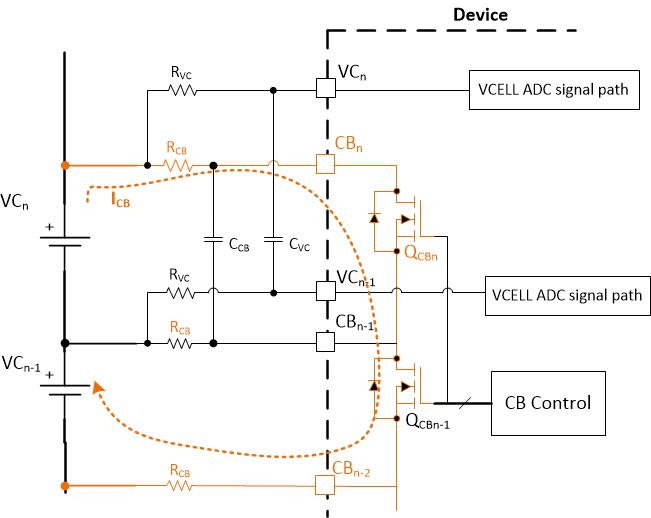SLVAE87A December 2020 – October 2023 BQ79600-Q1 , BQ79612-Q1 , BQ79614-Q1 , BQ79616-Q1 , BQ79652-Q1 , BQ79654-Q1 , BQ79656-Q1
- 1
- Abstract
- Trademarks
- 1 NPN LDO Supply
- 2 AVDD, CVDD outputs and DVDD, NEG5, REFHP and REFHM
- 3 OTP Programming
- 4 Cell Voltage Sense (VCn) and Cell Balancing (CBn)
- 5 Bus Bar Support
- 6 TSREF
- 7 General Purpose Input-Output (GPIO) Configurations
- 8 Base and Bridge Device Configuration
- 9 Daisy-Chain Stack Configuration
- 10Multi-Drop Configuration
- 11Main ADC Digital LPF
- 12AUX Anti Aliasing Filter (AAF)
- 13Layout Guidelines
- 14BCI Performance
- 15Common and Differential Mode Noise
- 16Revision History
4.2.2 Adjacent Cell Balancing
Manual balancing control is configured by setting [AUTO_BAL] = 0. In manual balancing control mode, the host can enable two consecutive CBFETs, and a maximum of eight total CBFETs can be enabled (see Figure 4-4).
However, when two adjacent channels are enabled, the balancing current is twice as high or higher than the non-adjacent channel balancing current. The system designer shall take this into account if adjacent cell balancing is used. See Equation 4 to select the right adjacent cell balancing series resistor (RCB).
 Figure 4-4 Adjacent Cell
Balancing
Figure 4-4 Adjacent Cell
Balancing